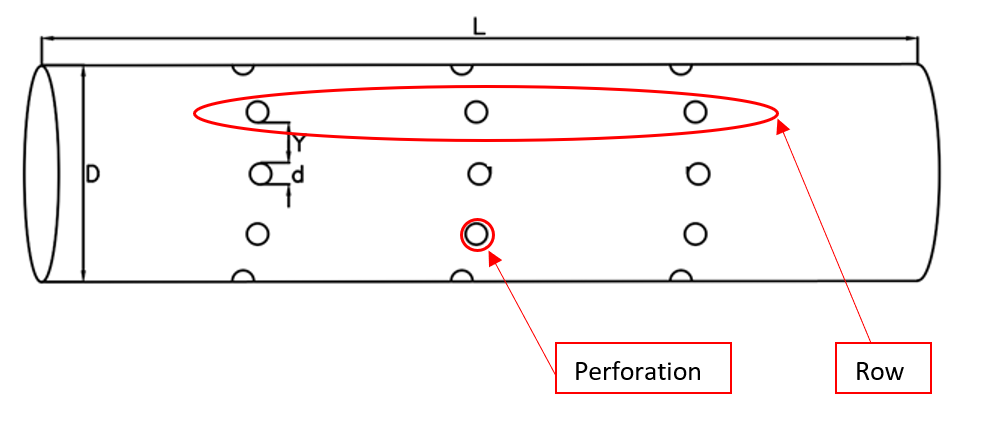For VO LID commands, there are two ways to specify the outflow capacity of the underdrain: 1) Stage Discharge Curve and 2) Orifice’s Equation. In the first option, user will enter the table of discharging rate – depth above subdrain manually. By the second option, the stage-discharge will be calculated with orifice’s equation.
Parameters
As shown below, there are two groups of parameters for Orifice’s Equation option.

- Group 1 includes pipe diameter, manning’s coefficient and slope, with which the max flow could be calculated using Manning’s equation.
- Group 2 parameters specify the layout of the perforations so the depth-discharge curve could be calculated with Orifice’s equation. The curve then will be checked against the max flow.
Layout of Perforations
As shown in the diagram below, the perforations are assumed to be placed in horizontal rows and evenly distributed along pipe circumference.

D = Diameter of Pipe (mm)
L = Length of Pipe (m)
Y = Minimum Space Between Perforations (in both vertical and horizontal direction) (m)
d = Diameter of Perforations (mm)
X1 = Perforations Per Row
X2 = Number of Rows
If the number of rows is even number (e.g. X2 = 4), it’s assumed the perforations are placed on both sides. If it’s odd number (e.g. X2 = 5), it’s assumed that one of the perforations is on the top and the rest are placed on both sides.
Max Depth
All layers above the underdrain pipe will be considered in the calculated depth-discharge curve. For example, a bioretension system with 0.2m of ponding, 0.3m of mulch, 1m of engineered soil and 1m of storage will have max depth of 2.5m (0.2 + 0.3 + 1 + 1).
Calculation
The flow though the perforations is calculated using orifice’s equation.

where:
= Orifice Coefficient
= Perforation Area (m2)
g = Acceleration from gravity (9.81 m/s2)
H = Head (m)
SF = Safety factor.
Note that the head is different for perforations at different level.
Warnings and Errors
The warnings and errors associated with underdrain parameters are list below.
- Error: Length of pipe shouldn’t be longer than the LID
It indicates that the perforated pipe is longer than length of LID. Consider changing one of them. - Error: Check (Diameter of Perforations + Minimum Spacing)*Number of Rows cannot be larger than Pipe Circumference
This is to check that the total of perforation and spacing along circumference. Decreasing the number of rows or diameter of perforations would remove the warning. - Error: (Diameter of Perforations * PerforationsPerRows + Minimum Spacing * ( PerforationsPerRows + 1 ) ) cannot be larger than the pipe length
This checks the horizontal dimension setting. Consider decreasing the number of perforations per row or increasing the pipe length. - Warning: The discharge to underdrain based on orifice equation is larger than maximum flow allowed through underdrain based on Manning’s Equation.
This checks the max discharge in depth-discharge curve against max manning’s flow. Consider decreasing the number of perforations or increasing the slope of the pipe.




